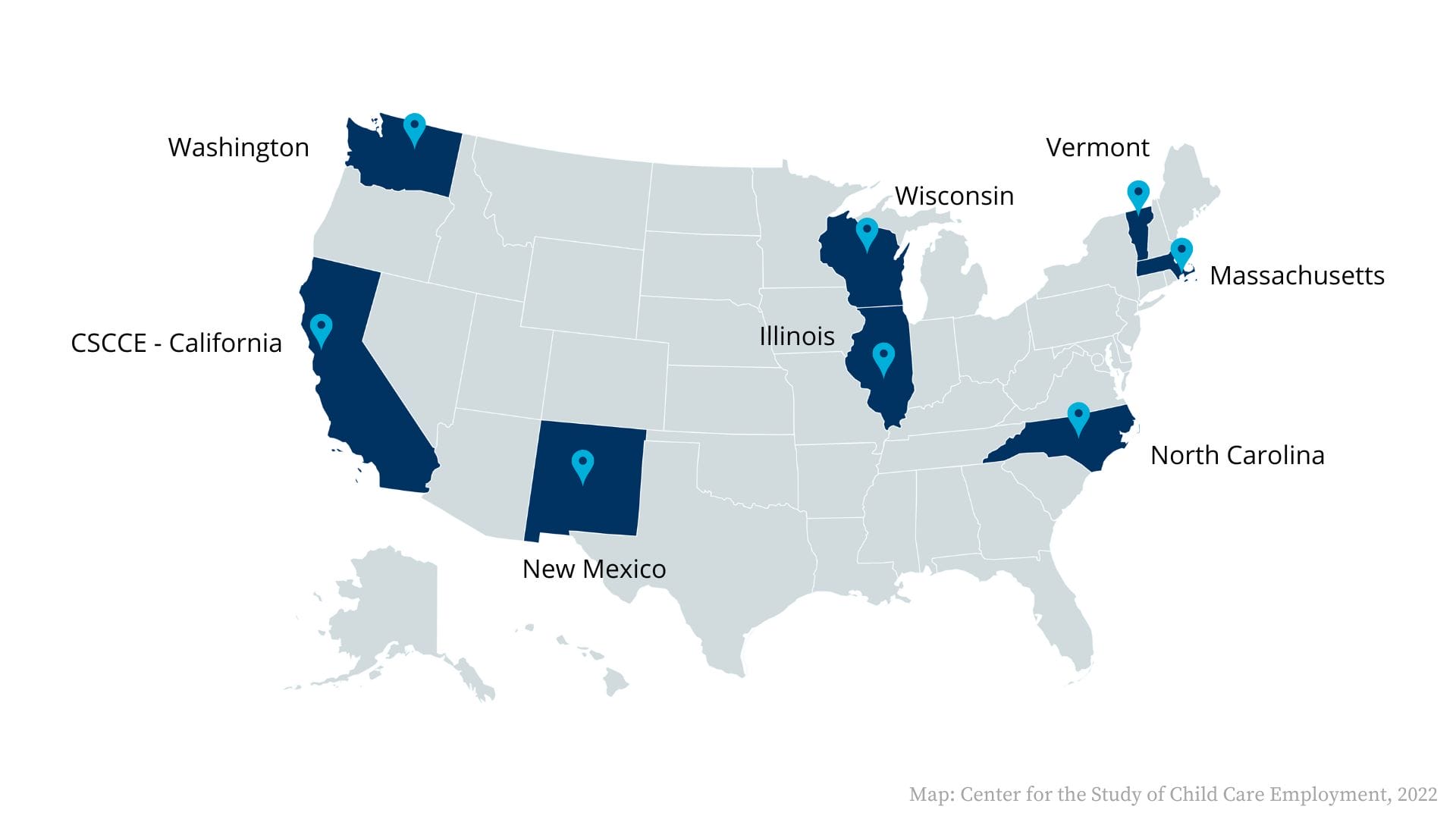Over the past two years, pandemic funds like the American Rescue Plan Act (ARP) served as much-needed relief for our early care and education (ECE) system, a system in the midst of collapse.
Introduction
ARP dollars provided an opportunity to think differently about how we resource the early care and education workforce—those who work with children prior to kindergarten. However, emergency funding is insufficient to comprehensively address the long-standing low pay and lack of benefits facing early childhood educators. As the deadline for spending ARP funds approaches, what can we learn from state efforts to improve ECE compensation so that we see permanent change? Even as we acknowledge how racism, sexism, and classism have shaped the current ECE system, including our inadequate subsidy system, how do we ensure that policymakers design and implement compensation solutions equitably?
The Center for the Study of Child Care Employment (CSCCE) at UC Berkeley convened 20+ advocates and policymakers from seven states for the Bold on Early Educator Compensation Learning Community to dive into these questions in 2022.
CSCCE’s Bold on Compensation Learning Community
Participants Include ECE leaders and advocates from seven states

Together, we shared challenges and strategies for progress on compensation for early educators. Insights from guest speakers advancing compensation progress in other places, such as Washington, D.C., supported our collective understanding. In this brief, we will review the key themes and lessons that emerged:
- Act Now and Lay Groundwork for Compensation Reform
- Dedicate Funds
- Center Educator Voices
- Build Data and Evaluation Capacity
- Take a Holistic Approach
We Asked the Bold on Early Educator Compensation Learning Community: What Does Being “Bold on Compensation” Mean?
“A wage that is equal to our other teaching counterparts along with benefits (health, retirement, paid time off, holiday pay).”
— Learning Community Participant
“Sustainable, scalable policy changes that can permanently effect increases in child care wages (not bonuses or supplements).”
— Learning Community Participant
“It means coming up with innovative new approaches to funding that have the potential to support adequate compensation for the entire field, not just some sectors.”
— Learning Community Participant
Act Now and Lay Groundwork for Compensation Reform
Many Bold on Compensation state leaders acted quickly to deploy ARP funds with immediate support for the early childhood workforce. They used strategies like direct payments to early childhood educators or requirements that ARP stabilization grants be used for staff compensation.
State leaders didn’t stop at short-term relief payments, but seized the opportunity to build out infrastructure for sustained compensation reform. Some even made it a special priority to boost access to funds for under-resourced programs and educators in an effort to address long-standing inequities in ECE funding.
For example, during the pandemic, Vermont’s governor authorized $6 million for quarterly retention bonuses for early childhood educators, and the state congress laid the groundwork for systemwide reform of the state’s child care system with 2021 legislation. Vermont advocates, Let’s Grow Kids are now working on establishing minimum compensation standards and looking ahead to legislation that would sustain funding for increased compensation across the field. In New Mexico, direct payments were delivered to the workforce as a pandemic relief strategy, and the state recently allocated ARP funds for a $3/hour wage increases for all early childhood staff, including non-teaching personnel, in licensed centers and home-based programs.
What Forward-Thinking Actions Can States Take to Build Infrastructure for Increased Pay and Benefits?
Fund and Implement a Salary Scale
A salary scale sets benchmarks for clearly differentiated salary increments based on qualifications and years of experience, which provide guidance for salary increases over time. It is crucial to develop a salary scale with an equitable methodology that includes all sectors and settings in ECE to avoid exacerbating inequities for educators of color, particularly Black educators, and those who work with infants and toddlers. Salary scales must be accompanied by appropriate levels of public funding to ensure programs are able to raise pay accordingly.
ARP funds provide an opportunity to encourage programs to use a salary scale and raise wages. North Carolina ARP grants included increased funding for compensation with an option to spend it on increased base pay for employees using the agency’s model salary scale. The grant also implemented an equity adjustment to the base stabilization grant amount for programs serving a higher percentage of infants and toddlers.
Ensure Funds and Access for Benefits
Washington State continues to cover healthcare premiums for employees of licensed child care facilities. This initiative was started with ARP funds and is planned to continue in 2023 with additional state subsidies.
Going beyond ARP funds, Washington, D.C., ensures premium-free healthcare coverage for early educators. The Office of the State Superintendent of Education, in partnership with the District’s Health Benefits Exchange, authorizes this benefit as part of the Early Childhood Educator Pay Equity Fund.
Too often, early educators do not have access to affordable child care for their own children. Using ARP funds, Kentucky ensures that all early childhood professionals working in a regulated licensed center or certified family child care home are automatically eligible for child care subsidies through the Child Care Assistance Program (CCAP), regardless of their household income.
Dedicate Funds
Even with ARP funds, the current subsidy system and federal funding for ECE programs are insufficient. Time and time again, Learning Community discussions landed on the need for increased and stable funding for early care and education. Recognizing this need, some states have already allocated funds that will be in place as ARP runs out.
New Mexico: Advancing a Sustained Revenue Strategy for Early Care and Education
In 2022, New Mexico voters permanently enshrined annual funding for early childhood education from the Land Grant Permanent Fund. This substantial victory was the result of years of strategic organizing by providers and communities across the state.
To identify the amount of funds needed for compensation, states can use dynamic cost models that include wages and benefits across a range of settings (e.g., centers, home-based providers) and variables (e.g., classroom size, staffing). For example, New Mexico used a cost model to increase subsidy rates. And in Washington, D.C., the Early Childhood Educator Equitable Compensation Task Force’s final recommendations used a 2021 cost model to estimate the cost of implementing a salary scale that would dramatically raise wages across the field.
In addition to identifying a funding source or amount, establishing a funding mechanism matters. Simply raising reimbursement rates will not equitably address compensation across the sector. Stable, upfront funding is essential for programs to actualize desired increases in compensation and allow agencies to particularly target under-resourced programs.
Illinois and Massachusetts: Pursuing Stable Funding Mechanisms Such as Contract and Grant Programs
Recognizing a need for stable, consistent funding, Illinois intentionally expanded its use of contracts to increase compensation, in part through the ExceleRate Illinois pilot project funded with a Preschool Development Birth-Five (PDG B-5) grant.
Many states recognize that the ARP stabilization grants can serve as a prototype for an operational grant program that could support programs and compensation. In Massachusetts, a total of $400 million has been allocated for an operational grant program that extends the C3 ARP stabilization grants through June 2023.
Center Educator Voices
The Learning Community aligned on the need to center early educators as experts, partners, and advocates in crafting compensation strategies. Participant Corrine Hendrickson, a Wisconsin-based family child care educator and owner, wrote a blog post about her journey as an advocate. Her story reminds us that educator engagement can happen at every point in the design, implementation, and iteration of policies. Nevertheless, the labor and contributions of educators must be supported financially and logistically. Intentional supports like providing stipends, guaranteeing substitutes in the classroom, and planning accessible meeting times and locations make engagement possible.

Centering educators also means designing compensation initiatives to address structural inequities, so that individuals—especially those who have historically experienced barriers to resources—can actually access them. Illinois prioritized streamlining applications and reducing barriers to access for state-administered COVID relief funds, some of which could be used for compensation. In other states, intermediary organizations (like WECAN Shared Services Alliance in Wisconsin) aided home-based providers in applying for COVID relief programs and channeled feedback to the agency.
Washington state: Centering Educator Perspectives in Compensation Policy Recommendations
Policymakers must particularly uplift provider voices that are too often underrepresented, such as educators of color, educators from immigrant communities, and educators who work in home-based programs.
For example, Child Care Aware of Washington is using the National Equity Project’s liberatory design framework to convene a group of 25+ early educators from diverse backgrounds and ECE settings to uplift their experiences and expertise in recommendations for compensation policy.
Build Data and Evaluation Capacity
Data collection, analysis, and reporting that reach the whole sector (child care in homes and centers, pre-K and Head Start programs) and support program evaluation continues to be a challenge. This effort will require additional public investment and state agency capacity. Comprehensive workforce data plays an essential role in identifying what is needed to adequately resource the system, who is furthest from opportunity, and the impact of implemented policies. However, states are not starting from scratch: many states have workforce registries and/or workforce studies that can be leveraged or expanded to understand changes in early educator compensation over time, including as a result of policy change.
North Carolina and Delaware: Addressing Compensation in Data Collection
The Administration for Children and Families provides helpful reports on state ARP grant programs. However, since not all states require using the grants for compensation, the amount spent on compensation is not always available.
North Carolina maintains a dashboard showing the amount of ARP grants going to compensation. As of Fall 2022, ARP grants reached more than 3,000 programs, with more than $170 million going to compensation in centers and $9 million to compensation in family child care. Building on detailed data collection efforts, Child Care Services Association reports how many and what kinds of programs opted into the compensation options (to raise base pay or to provide staff bonuses). Their findings demonstrate that when programs have the resources, directors will overwhelmingly choose to raise base pay for their staff. Because of a history of workforce studies, the ARP grant-use data in North Carolina can be contextualized using data on educator salaries and access to benefits prior to implementing the grant.
Delaware recently legislated an annual workforce study including demographics and estimated cost to close the gap between current compensation and a target wage scale.
Take a Holistic Approach
Lastly, a broad theme from the Learning Community is the need to advance compensation for the workforce as part of a holistic strategy. Forward-thinking leaders must consider how compensation reform can advance alongside a range of interconnected policies like enforcing work environment standards, removing barriers to higher education, and investing in ECE infrastructure and data systems. Washington D.C. provides the best example of a holistic and equitable compensation strategy to date.
Washington, D.C.: Advancing a Holistic Vision for Equitable Early Education Compensation
The District of Columbia leads on early educator compensation by advancing multiple strategies that build on each other.
- In 2018, the D.C. Council passed the Birth to Three Act calling for publicly funded early educator pay parity with elementary public school teachers with equivalent roles, credentials, and experience.
- The District phased in higher qualification standards and made efforts to support the workforce by investing in scholarships and reducing barriers to higher education.
- Starting in October 2022, the Act requires reimbursement rates to providers based on a cost model that incorporates an updated salary scale.
- Since the compensation aspect of the 2018 legislation remained unfunded and raising child care reimbursement rates does not mean a substantial raise in pay, a local revenue source was authorized to fund educator pay and a task force for early childhood educator pay equity was convened in 2021.
- The task force advanced recommendations for historically significant one-time direct payments to educators and a long-term plan with a salary scale across settings to raise pay to parity for all early educators, including infant-toddler teachers.
- Not stopping at pay, the task force pushed for funding for health benefits.
- The task force continues to improve workforce data to understand and disrupt inequities in compensation and work environments.
It was not easy. More than a decade of strategic organizing and uplifting educator voices led to this significant progress on compensation.
In Closing
States do not need to take a decade to make progress on workforce compensation, and frankly, early educators and the children, families, and communities they support cannot afford to wait. Recognizing the power of collective understanding, the Learning Community created a space for cross-state capacity building, so that leaders in participating states can learn from one another and inspire greater change. Following models like New Mexico, the District of Columbia, and others, state leaders across the country can think beyond the sunset of ARP funds and take bold strides to address early educator compensation.



